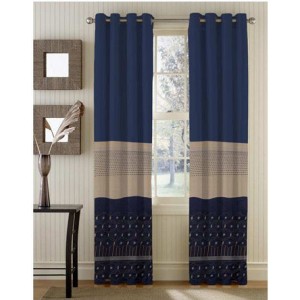Measuring your windows to determine what you need to cover your windows should not be difficult and this guide is designed to make measuring your windows a relative snap. The only real decisions you need to make are whether or not to hang your rod on the window frame or a couple of inches above it and whether you’ re looking for a tailored look, a standard look or a very full gathered look for your coverings (more about that later. See the How Many Drapery Panels Do I Need section). Just note the first measurement listed is the width and the second one is the length. For example if the package says 50” x 84” , 50” is the width and 84” is the length of the panel.
Unless you have high ceilings, most windows we’ ve come across should work fine with an 84” length drape.
But either way, let’ s go through the drill so you know exactly what you need.

What Length Drapes Do I Need?
- Decide how high to set the drapery rod. For most windows, setting the rod on a wall mount (A on the diagram above) a few inches above the window frame should suffice. For low light– filtration, mount the curtain rod 6" above the trim and allow the rod width to extend 3" beyond the window's actual width.
However, if you have low ceilings or if you want a more casual look then a trim mount (Figure B) is just fine. I have a trim mount for my bedroom curtains and it works well. If you are looking for a more dramatic look, attaching the rod against the ceiling will add height to the room. Generally, this type of mount looks best with silk type drapes and heavier drapes such as microsuedes or velvets.
- Once you’ ve decided where you want to mount your rod, measure down to where you want the drapes to land. We recommend going for a floor length look (Figure E) as opposed to a window sill mount (in our view, a sill mount looks good only for kitchen curtains and is best for a window shade as opposed to a drape).
Drapes with decorative tops, such as rings or tie– tops, are measured from the top of the panel, not including the decorative element. Consider the length of the top treatment when determining the length needed.
People tend to ask whether or not they should pool their drapes on the floor. Having your drapes at the floor or even a few inches above is fine. I tend to have my drapes a few inches above the floor as I’ m not a big fan of having the drapes collect dust. Plus it’ s easier to vacuum around the drapes.
However, if you want a dramatic look, pool the drapes a few inches on the ground and add 6 to 8 inches to your length measurement. Just be aware of the dust bunnies and that you may need to wash the drapes more often especially if you have kids or pets who like to hide behind the drapes.
In brief: Measure the length of your window, decide whether you want the drape to fall above the sill (measure from A or B to C), below the sill (from A or B to D) or to the floor (from A or B to E). If you'd like longer drapes that pool on the floor in luxurious folds, add 6– 8'' to the height measurement.
How Many Drapery Panels Do I Need?
Measure the width of your window treatments, taking into account whether you'd like a wall mount (A) or a trim mount (B). Allow 1– 3" on each side of the window for when the drapes are completely open. Also, be sure to think about the extra wall space needed for decorative finials, as the rod dimensions do not include the length of the finial.
To determine how many panels you need to achieve the desired fullness, take the window's width measurement and multiply it by 1 for a tailored look, 1.5 to 2 for a standard look, or 3 for a full look. For example, if you like a standard look and the window is 40" wide, you'll need 60" of panel width (40" x 1.5). If the width of the drape is 50” then you would buy 2 panels to achieve a standard look.
Aucun commentaire n'a été publié pour le moment.
Seuls les utilisateurs enregistrés peuvent poster des commentaires.






